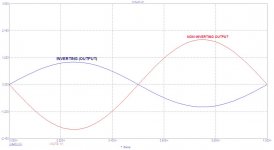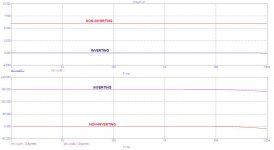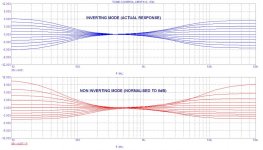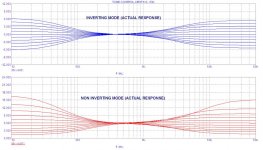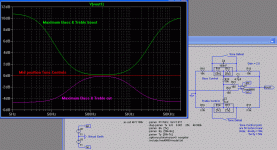Tone Control Questioned
Hi Geatan/and others,
Why was it not immediately apparent how inadequately a non-inverting gain-stage (op-amp) performs in a tone control application where symmetry in potentiometer setting (boost/cut) and linearity is the objective?
The graph of HAKSA tone control shown in your post is not at all representative of a tone control using a non-inverting gain-stage with the tone network in the feed-back loop.
I am sorry if I am being hard on you Geatan, but it is unfair to other readers of this thread (not having the skill to question) thinking that what they are going to build is a symmetrical bass & treble control (which is what your graph shows) while this is not the case at all.
Besides to achieve a "semi flat" response with the current design, the controls would have to be set closer to a 2 or even 3 o'clock position and not a 12-o'clock position that one would expect to achieve a flat response.
The objective of a group design is for skilled members to highlight problem areas and offer possible solutions.
The current tone control in my opinion is inadequate and the weak link in this simple HAKSA design. If nothing else I would encourage it to be a simple passive circuit and humping up the amp gain to counter for the losses.
Kind regards
Nico
Hi Geatan/and others,
Why was it not immediately apparent how inadequately a non-inverting gain-stage (op-amp) performs in a tone control application where symmetry in potentiometer setting (boost/cut) and linearity is the objective?
The graph of HAKSA tone control shown in your post is not at all representative of a tone control using a non-inverting gain-stage with the tone network in the feed-back loop.
I am sorry if I am being hard on you Geatan, but it is unfair to other readers of this thread (not having the skill to question) thinking that what they are going to build is a symmetrical bass & treble control (which is what your graph shows) while this is not the case at all.
Besides to achieve a "semi flat" response with the current design, the controls would have to be set closer to a 2 or even 3 o'clock position and not a 12-o'clock position that one would expect to achieve a flat response.
The objective of a group design is for skilled members to highlight problem areas and offer possible solutions.
The current tone control in my opinion is inadequate and the weak link in this simple HAKSA design. If nothing else I would encourage it to be a simple passive circuit and humping up the amp gain to counter for the losses.
Kind regards
Nico
Attachments
Thanks Gaetan!
Very nice graph, you did that in Tina?
When you gun for more cut/boost with the circuit used in the HAKSA, when controls are flat there are serious discrepancies in the FR. With the values chosen, there is no such effect, but cut/boost are limited, also by the non-inverting issue, which is not usual for a conventional Baxandall and I wanted to avoid. Without the small 22pF cap on the fb loop of the opamp, there is serious gain peaking, but with it, all is well.
Merci,
Hugh
I am sorry Hugh, but I do not agree with you. See previous post.
Nico
Response Curves for inverting & non-inverting comparison
What I am attempting to demonstarte is the difference between the response curves for the bass and treble control in the feed-back loop utilising either non-inverted and inverted configurations.
You can clearly see the non-linear operation of the tone controls in non-inverted mode.
On the other hand if this appeals to you then so be.
What I am attempting to demonstarte is the difference between the response curves for the bass and treble control in the feed-back loop utilising either non-inverted and inverted configurations.
You can clearly see the non-linear operation of the tone controls in non-inverted mode.
On the other hand if this appeals to you then so be.
Attachments
Some thoughts for the day
In my humble opinion, if one's objectives are that of wanting to listen to reality, then strict engineering sciences are applied with know quantities and a predictable outcome.
Audiophile hocus pocus has been for years trying to justify their existence using buzzwords such as focus, clarity, pin point, sound stage and all the other cr@p that they imagine but what audio engineers have been enjoying since the outset.
Imagine watching TV and fiddling with the chroma, contrast, etc to obtain a picture that you like and then walking into nature and seeing that it is totally different, then obviously nature must be wrong because the TVphile proving this to himself that he is right.
Take your audiophile hocus pokus equipment if you are not afraid, record the birds and animals and then play it back, see what you attract and scare away. The outcome is that your hi-fi equipment was designed by Audio Wizard so-and-so obviously the birds does not appreciate his subjective skills or generally birds are deaf.
The best fire-walk for your equipment is to grab your guts together, creep up on a lion male and record his call. This has been proven to be heard over 5 km away as food becomes very nervous even at that distance. Now replay what you have recorder and see if any food would be nervous at 5km away or are they just continuing as normal. The conclusion probably would be antelopes are deaf but they small the lions breath and get nervous.
My dog is totally afraid of fire crackers, try recording them and playing it back, how is the response of the dog who actually reacts on an audio signature not whether it is a warm cracker, a focused cracker, crisp cracker, an over dose of 2nd Harmonic and some feed forward compensation cracker, or a deep solid cracker.
When I do a cracker on my system the dog vanishes into thin air.
The same applies with tuning a car engine by ear or by sophisticated analysers thinking the hocus pocus guy is going to win the grandprix. No chance, the best engineering team is.
One should remove the jargon and Black Magic from amplifier design and rely on engineering science and first principles when developing a product leave guessing to those ill informed. Do something with conviction, do it properly and do it right (first time is nice)
These audiophiles have to first sell you the jargon and other hocus pocus, there after you are so tired that you buy the product untested becoming a disciple of the cult.
I told Hugh about my final amp I built. It was playing in the background when a Buddy/business associated walked in, stood still for about ten seconds and said I will give you $35000 for that. I was not even playing anything spectacular nor did I object and immediately proceeded to move the equipment to his house. I never had to tell him to listen to this or that, it was clearly the perfect product.
I say steer away from hocus pocks because if you do not, for the rest of your life you will have to prove to yourself that what you have is good while it is totally mediocre.
Nico
In my humble opinion, if one's objectives are that of wanting to listen to reality, then strict engineering sciences are applied with know quantities and a predictable outcome.
Audiophile hocus pocus has been for years trying to justify their existence using buzzwords such as focus, clarity, pin point, sound stage and all the other cr@p that they imagine but what audio engineers have been enjoying since the outset.
Imagine watching TV and fiddling with the chroma, contrast, etc to obtain a picture that you like and then walking into nature and seeing that it is totally different, then obviously nature must be wrong because the TVphile proving this to himself that he is right.
Take your audiophile hocus pokus equipment if you are not afraid, record the birds and animals and then play it back, see what you attract and scare away. The outcome is that your hi-fi equipment was designed by Audio Wizard so-and-so obviously the birds does not appreciate his subjective skills or generally birds are deaf.
The best fire-walk for your equipment is to grab your guts together, creep up on a lion male and record his call. This has been proven to be heard over 5 km away as food becomes very nervous even at that distance. Now replay what you have recorder and see if any food would be nervous at 5km away or are they just continuing as normal. The conclusion probably would be antelopes are deaf but they small the lions breath and get nervous.
My dog is totally afraid of fire crackers, try recording them and playing it back, how is the response of the dog who actually reacts on an audio signature not whether it is a warm cracker, a focused cracker, crisp cracker, an over dose of 2nd Harmonic and some feed forward compensation cracker, or a deep solid cracker.
When I do a cracker on my system the dog vanishes into thin air.
The same applies with tuning a car engine by ear or by sophisticated analysers thinking the hocus pocus guy is going to win the grandprix. No chance, the best engineering team is.
One should remove the jargon and Black Magic from amplifier design and rely on engineering science and first principles when developing a product leave guessing to those ill informed. Do something with conviction, do it properly and do it right (first time is nice)
These audiophiles have to first sell you the jargon and other hocus pocus, there after you are so tired that you buy the product untested becoming a disciple of the cult.
I told Hugh about my final amp I built. It was playing in the background when a Buddy/business associated walked in, stood still for about ten seconds and said I will give you $35000 for that. I was not even playing anything spectacular nor did I object and immediately proceeded to move the equipment to his house. I never had to tell him to listen to this or that, it was clearly the perfect product.
I say steer away from hocus pocks because if you do not, for the rest of your life you will have to prove to yourself that what you have is good while it is totally mediocre.
Nico
Hi Geatan/and others,
Why was it not immediately apparent how inadequately a non-inverting gain-stage (op-amp) performs in a tone control application where symmetry in potentiometer setting (boost/cut) and linearity is the objective?
The graph of HAKSA tone control shown in your post is not at all representative of a tone control using a non-inverting gain-stage with the tone network in the feed-back loop.
I am sorry if I am being hard on you Geatan, but it is unfair to other readers of this thread (not having the skill to question) thinking that what they are going to build is a symmetrical bass & treble control (which is what your graph shows) while this is not the case at all.
Kind regards
Nico
Hello Nico
The first simetrical graph was the Quad 34 preamp as I said, comming from Quad web site.
So I never said that Haksa tona amp graph was simetrical, but that it was less strong boost that the Baxandal type tone control.
And for the simulation I can't do other sim since my Tina-Ti simulator don't work properly.
Bye
Gaetan
Nico,
Your virtual earth and crossfeed contributions have been both excellent and gratefully received. I believe we are all grateful for them.
I did not want a tone control for this circuit to begin with, but clearly it was a desired feature and so I agreed. You and I have discussed audio engineering at length and agreed that phase shift, filter or no filter, is undesirable. The non-inverting tone control, at the expense of a large control range, offers tiny phase shifts with gentle, albeit asymmetrical control, and that was, and remains, my choice. Set flat, there is almost no tone alteration and vanishinly low phase shift to the point where a defeat is not strictly needed. Correcting for mid-point flat setting should be easy with the output fixed resistors. Inverting the signal, right or wrong, is regarded by most in audio as a bad thing (although it can be remedied easily with a simple speaker lead swap) so I favoured that aspect too.
I think all here recognise your consummate abilities as an engineer. Low distortion is desirable, no question, but many high distortion circuits, notably single ended Class A, sound pretty good too, so there would appear to be more to it than very low THD20. Gaetan was using Tina for his simulations - flawed by his own admission - so I don't believe he should be upbraided for his post. No one is trying to be a 'guru' here, or a smartarse, so I'm at a loss to understand why you are invoking the high priesthood and highlighting the hocus pocus aspects so strongly. That is very alienating, and it is most unlike you.
Until I have a better option, I choose to continue with this tone tilt circuit for the reasons given, but I am grateful for, and will use, both your crossfeed and the virtual earth concepts. I'm hoping you will still be willing to lay out the pcb, too.
With thanks,
Hugh
Your virtual earth and crossfeed contributions have been both excellent and gratefully received. I believe we are all grateful for them.
I did not want a tone control for this circuit to begin with, but clearly it was a desired feature and so I agreed. You and I have discussed audio engineering at length and agreed that phase shift, filter or no filter, is undesirable. The non-inverting tone control, at the expense of a large control range, offers tiny phase shifts with gentle, albeit asymmetrical control, and that was, and remains, my choice. Set flat, there is almost no tone alteration and vanishinly low phase shift to the point where a defeat is not strictly needed. Correcting for mid-point flat setting should be easy with the output fixed resistors. Inverting the signal, right or wrong, is regarded by most in audio as a bad thing (although it can be remedied easily with a simple speaker lead swap) so I favoured that aspect too.
I think all here recognise your consummate abilities as an engineer. Low distortion is desirable, no question, but many high distortion circuits, notably single ended Class A, sound pretty good too, so there would appear to be more to it than very low THD20. Gaetan was using Tina for his simulations - flawed by his own admission - so I don't believe he should be upbraided for his post. No one is trying to be a 'guru' here, or a smartarse, so I'm at a loss to understand why you are invoking the high priesthood and highlighting the hocus pocus aspects so strongly. That is very alienating, and it is most unlike you.
Until I have a better option, I choose to continue with this tone tilt circuit for the reasons given, but I am grateful for, and will use, both your crossfeed and the virtual earth concepts. I'm hoping you will still be willing to lay out the pcb, too.
With thanks,
Hugh
I agree with Nico's arguments, but I feel he set himself up to be misunderstood, and also went off-topic.
Nico seems to have observed how most of us seem to be either pulling teeth or picking out small things that aren't really important. I think it angers him that we aren't being very strict logically and are unorganized; we have made many guesses where it would have been simpler and faster to pull out a calculator. I've felt the same frustration, so I think I can relate to Nico.
I don't see an issue with the odd tone controls as long as the signal itself isn't distorted.
- keantoken
Nico seems to have observed how most of us seem to be either pulling teeth or picking out small things that aren't really important. I think it angers him that we aren't being very strict logically and are unorganized; we have made many guesses where it would have been simpler and faster to pull out a calculator. I've felt the same frustration, so I think I can relate to Nico.
I don't see an issue with the odd tone controls as long as the signal itself isn't distorted.
- keantoken
KT,
This is always the price of design by committee. While it is true you can't keep everyone happy, when tempers fray wheels fall off the wagon, and there is absolutely no need for heated argument. Progress is slow, and people's expectations can be inordinately high in terms of quality and time to market, but it's just not possible to move quickly on these things, precisely because we do want it engineered right.
John, if you are not happy with proceedings you might like to suggest an improvement. I believe you realise we are happy to listen and will pay due attention.
This is a hobby project. It is not a money spinner, but it will be properly done. That will take a bit of time. Please keep the constructive comments coming.
Cheers,
Hugh
This is always the price of design by committee. While it is true you can't keep everyone happy, when tempers fray wheels fall off the wagon, and there is absolutely no need for heated argument. Progress is slow, and people's expectations can be inordinately high in terms of quality and time to market, but it's just not possible to move quickly on these things, precisely because we do want it engineered right.
John, if you are not happy with proceedings you might like to suggest an improvement. I believe you realise we are happy to listen and will pay due attention.
This is a hobby project. It is not a money spinner, but it will be properly done. That will take a bit of time. Please keep the constructive comments coming.
Cheers,
Hugh
Nico,
Many thanks, appreciate the sentiment.
Folks,
If we reduce the 4K7 resistors astride the Treble control to 3K9, we get the following curves for bass and treble.
View attachment 145589
Cheers,
Hugh
Hello Hugh
You also reduce the value of the nfb cap C1, from 22pf to 4,7pf.
22pf was too high ?
Thank
Bye
Gaetan
Hi Hugh/Geatan.
I apologize for having confronted you or Geatan with my recent posts, I sometimes lack moderation in this regard. It is not an issue of who is right or wrong.
My concern was that the performance graph presented by Geatan driven by his enthusiasm he may have massaged the schematic to produce the HAKSA curves and my reason for asking to post the schematic he was using.
You being the nice guy sanctioned the posting probably without thinking, and that was my real dig.
I am concerned for those less fortunate enthusiasts that may lack the understanding, skill or means to verify the performance for themselves, but set their expectations based on what is being bounced around in this thread.
Kindest regards
Nico
I apologize for having confronted you or Geatan with my recent posts, I sometimes lack moderation in this regard. It is not an issue of who is right or wrong.
My concern was that the performance graph presented by Geatan driven by his enthusiasm he may have massaged the schematic to produce the HAKSA curves and my reason for asking to post the schematic he was using.
You being the nice guy sanctioned the posting probably without thinking, and that was my real dig.
I am concerned for those less fortunate enthusiasts that may lack the understanding, skill or means to verify the performance for themselves, but set their expectations based on what is being bounced around in this thread.
Kindest regards
Nico
forget hifi,Some thoughts for the day
In my humble opinion, if one's objectives are that of wanting to listen to reality, .........................
....................I say steer away from hocus pocks because if you do not, for the rest of your life you will have to prove to yourself that what you have is good while it is totally mediocre.
Nico
Nico's post, in it's entirety, is asking us to go back to and try to achieve the ideals of High Fidelity in it's original meaning.
Long Live High Fidelity.
Hi Andrew,
Subjectivity exists in the human mind only. I cannot imagine anyone having to be connected to a hart lung machine one day not knowing whether it was tested subjectively or objectively.
If a desert dweller in the Sahara tells you that camel's tonsils taste nicest raw will you eat it?
If a leading physician tells scientific testing proved that camel's tonsils eaten raw will cure your cancer, will you eat it?
Subjectivity exists in the human mind only. I cannot imagine anyone having to be connected to a hart lung machine one day not knowing whether it was tested subjectively or objectively.
If a desert dweller in the Sahara tells you that camel's tonsils taste nicest raw will you eat it?
If a leading physician tells scientific testing proved that camel's tonsils eaten raw will cure your cancer, will you eat it?
Hello Nico
I forgot to say that the schematic I use for sim was exactly the one post by Hugh. But anyway my Tina still mixing up things, and LT-Spice are really not as easy to use for me.
It's an open thread so it's not easy to keep it on the goals fixed by Hugh for the Haksa and for sure that there are guy's who read it but can be a bit mix-up by so much ideas and suggestions.
But there is much worse threads in the forum, this one still quite well maner and civilize.
Bye
Gaetan
I forgot to say that the schematic I use for sim was exactly the one post by Hugh. But anyway my Tina still mixing up things, and LT-Spice are really not as easy to use for me.
It's an open thread so it's not easy to keep it on the goals fixed by Hugh for the Haksa and for sure that there are guy's who read it but can be a bit mix-up by so much ideas and suggestions.
But there is much worse threads in the forum, this one still quite well maner and civilize.
Bye
Gaetan
Hi Andrew.
(Sorry Hugh this is again off topic I apologise.)
The design and engineering integrity of a piece of audio equipment should be as critical as anything else.
How would one feel if the designers of computing equipment randomly adds a few zeros or ones because the results might be more pleasing. Maybe Dell adds more ones and IBM more zeros to please a certain market sector.
In my humble opinion only an amplifier that adds zero artifacts can sounds real, whether it sounds nice has nothing to do with it.
If this is not the case then we all should go to live theatre wearing hearing aids so that we can adjust the natural sound until it appears pleasing.
I think there are more seeking reality than meets the eye. I followed patchwork rather quietly and (real name removed at members request), I guarantee is at least one other person that feels strongly about this.
(Sorry Hugh this is again off topic I apologise.)
The design and engineering integrity of a piece of audio equipment should be as critical as anything else.
How would one feel if the designers of computing equipment randomly adds a few zeros or ones because the results might be more pleasing. Maybe Dell adds more ones and IBM more zeros to please a certain market sector.
In my humble opinion only an amplifier that adds zero artifacts can sounds real, whether it sounds nice has nothing to do with it.
If this is not the case then we all should go to live theatre wearing hearing aids so that we can adjust the natural sound until it appears pleasing.
I think there are more seeking reality than meets the eye. I followed patchwork rather quietly and (real name removed at members request), I guarantee is at least one other person that feels strongly about this.
Hi Andrew,
Subjectivity exists in the human mind only. I cannot imagine anyone having to be connected to a hart lung machine one day not knowing whether it was tested subjectively or objectively.
If a desert dweller in the Sahara tells you that camel's tonsils taste nicest raw will you eat it?
If a leading physician tells scientific testing proved that camel's tonsils eaten raw will cure your cancer, will you eat it?
Hello Nico
Yes, a bit off topic, so I will not post more about that subject, but it was interesting,
Wen it come to sound systems, especially high-end types, it's a mix of objectivity and subjectivity in the way our brain and psycology received the sonic and musical results.
And even in a circuits designs I've seen lot of subjectivities in the Diy Audio forum.
But numbers don't say all, mostly because we need new and better measuring technics in a dynamic way with real load, others and better than distortions, phases, slew-rate, response measurements who are done in a static way. Maby tone-bursts distortions and and FFT measurements.
So many times the listening test contradict the measurements.
Bye
Gaetan
Last edited:
- Home
- More Vendors...
- AKSA
- Aspen Headphone Amp
